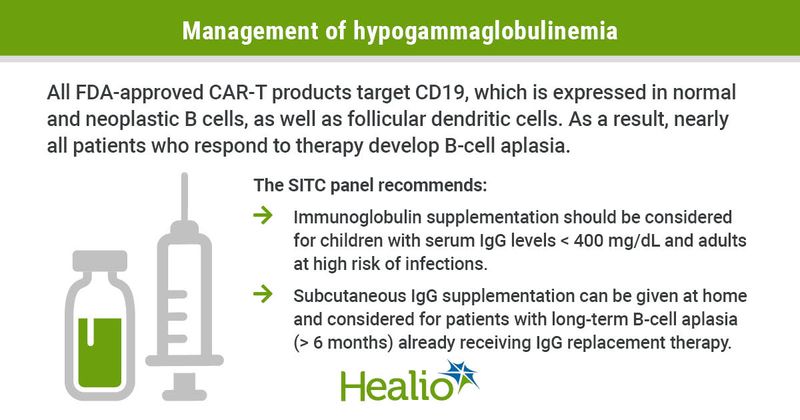Guidelines provide consensus on management of CAR T-cell therapy-related toxicities
Click Here to Manage Email Alerts
The Society for Immunotherapy of Cancer published clinical practice guidelines on the management of toxicities related to the use of immune effector cell therapies, including chimeric antigen receptor T cells.
“The use of guidelines has time and again demonstrated improved outcomes for patients,” Marcela V. Maus, MD, PhD, director of the cellular immunotherapy program at Massachusetts General Hospital, associate professor of medicine at Harvard Medical School and member of the Cell Therapy Next Peer Perspective Board, told Healio. “These are complex new therapies with significant toxicities that are not frequently encountered in other settings.”

Healio spoke with Maus — lead author of the document and chair of the Society for Immunotherapy of Cancer (SITC) Immune Effector Cell-related Adverse Events Guideline Expert Panel — about the significance of the guidelines, published in Journal for ImmunoTherapy of Cancer, and how they can be applied to clinical practice.

“We hope that this set of guidelines will help clinicians make these difficult decisions and give them a place to turn to for guidance — from management of toxicities to infection prophylaxis,” she said.
Establishing consensus
SITC developed a series of clinical practice guidelines for the use of immunotherapies because society members felt there was a lack of consensus guidance on managing CAR T-cell therapy-related toxicities, Maus said.
Current practice is muddled and relies on expertise developed during clinical trials, she said, which has led to some providers having limited knowledge about toxicities related to specific products. Not all CAR T-cell therapies are associated with the same toxicities.
“There are some management algorithms that overlap and some that don’t,” Maus said. “We’ve identified some areas where things can be different with the CAR product, disease and patient population to come up with a comprehensive set of guidelines.”
The recommendations are based on published data and the experience of panel members.
The audience for the guidelines goes beyond hematologist/oncologists and includes oncology nurses, nurse practitioners and advanced practice providers — all of whom can benefit from guidance on appropriate toxicity management, Maus said. Pharmacists can refer to the document for guidance on which medications are used to prevent or resolve treatment-related adverse events and should be kept in stock, she added.
Key recommendations
The guidelines document provides recommendations in five general areas of adverse event management, followed by guidance on specific treatment-related toxicities.
The general recommendations cover:
- product-and patient-specific considerations;
- baseline evaluations before therapy;
- infection precautions and prophylaxis;
- special precautions for COVID-19; and
- grading of adverse events.
“The onset and severity of therapy-associated toxicities typically correspond with the timing and degree of peak CAR T-cell activation and proliferation, as well as underlying disease,” Maus and colleagues wrote. “Therefore, product and disease-specific characteristics may place some patients at higher risk for adverse events.”
Each CAR T-cell therapy has structural differences that contribute to its risk profile and should be considered in the management of treatment-related toxicities, the panelists added.
Higher disease burden before treatment is another consideration, as this can increase risk for treatment-related toxicities.
“Treatment decisions should be risk-adapted to take into account characteristics of individual patients and products, with earlier and more aggressive intervention warranted with higher risk,” the panelists wrote.
Another general recommendation is the use of the American Society for Transplantation and Cellular Therapy (ASTCT) consensus system to grade cytokine release syndrome (CRS) and immune effector cell-associated neurotoxicity syndrome (ICANS) — the two most frequently observed major toxicities associated with CAR T-cell therapy.
“Advantages to the ASTCT system are its ease of use, objectivity, solid basis on criteria that may be immediately assessed by all members of a caregiving team, and accuracy in categorizing the severity of toxicities,” Maus and colleagues wrote.
The guidelines document dives into each of the most frequent adverse events associated with CAR T-cell therapy and, where applicable, gives recommendations on laboratory parameters and baseline testing, identifying clinical symptoms, timing to onset of symptoms, risk factors and adverse event management. Toxicities for which the panel provided recommendations include CRS, hemophagocytic lymphohistiocytosis/macrophage activation syndrome-like toxicities, ICANS (including cerebral edema), cytopenias, cardiac toxicities and hypogammaglobulinemia.
The guidelines are intended to help guide and justify clinical decision-making and should not serve as a substitute for a clinician’s judgment, Maus said.
“It is meant to be educational and increase comfort level with these new therapies,” Maus told Healio. “We also hope that it helps patients and their advocates make decisions about their quality of life and in knowing what to expect in terms of acute and long-term toxicity and benefits.”
For more information:
Marcela V. Maus, MD, PhD, can be reached at Massachusetts General Hospital, 149 13th St., Room 3.216, Charlestown, MA 02129; email: mvmaus@mgh.harvard.edu.

